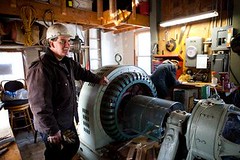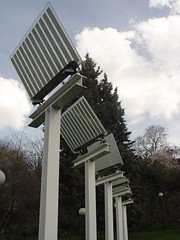And it is not just Minnesota’s government building momentum around an alternative energy future. The state’s Fortune 100 companies, such as Target and Best Buy, have set significant GHG reduction goals. Its power companies continue to expand renewable generation, including both solar and wind. And Minnesota’s civil society, pillared by organizations such as Great Plains Institute and Center for Energy and Environment, helps facilitate change and drive innovation in the energy and efficiency sector. That is why RMI was excited to support the Minnesota Department of Commerce in the development of a comprehensive guide to conducting an energy future study for Minnesota.You can imagine that somewhere in the faraway, fictional land of Lake Wobegon, solar panels are appearing atop barn roofs and wind turbines are gracing ridge lines.
A roving compendium of ecocentric energy options, including advances in solar and wind power, hybrid vehicles, and other thoughtful, balanced approaches to renewable energy.
Sunday, March 30, 2014
New Energy Strategy for Minnesota Evaluates Renewables
Thursday, June 27, 2013
Solar Panels Sound Death Knell for U.S. Utilities
The financial implications of these threats are fairly evident. Start with the increased cost of supporting a network capable of managing and integrating distributed generation sources. Next, under most rate structures, add the decline in revenues attributed to revenues lost from sales foregone. These forces lead to increased revenues required from remaining customers … and sought through rate increases. The result of higher electricity prices and competitive threats will encourage a higher rate of DER additions, or will promote greater use of efficiency or demand-side solutions.
Increased uncertainty and risk will not be welcomed by investors, who will seek a higher return on investment and force defensive-minded investors to reduce exposure to the sector. These competitive and financial risks would likely erode credit quality. The decline in credit quality will lead to a higher cost of capital, putting further pressure on customer rates. Ultimately, capital availability will be reduced, and this will affect future investment plans. The cycle of decline has been previously witnessed in technology-disrupted sectors (such as telecommunications) and other deregulated industries (airlines).
Saturday, April 09, 2011
Houston embraces renewable energy
Thursday, October 21, 2010
Solar power creates electric grid challenges in Germany

The accelerating adoption of solar panels in Germany looks like a case of too much of a good thing. The antiquated power grid across the country is having trouble coping with the fluctuations resulting from feed-ins from photovoltaic systems and wind turbines.
As reported in this UPI.com news story:
Experts have long called for an overhaul of the European power grid to integrate the fluctuating renewable energy sources such as solar and wind power.
Experts forecast between 8 gigawatts and 10 GW of solar power capacity to be installed this year -- the equivalent of roughly 10 large coal-fired power plants. In 2009, only 4 GW were installed.
With an equally fragmented and outdated power grid, the U.S. would do well to overhaul its own infrastructure in preparation for more extensive use of renewable energy. Google's investment in the Atlantic Wind Connection is a step in the right direction.
Tuesday, May 12, 2009
Microgeneration by Hydropower

New England mill towns have a long history of tapping into the power of water running downhill. In the Orion Magazine article, The Poetry of Power, Ginger Strand profiles the resurgence of hydro sites in the area and the role of Verne Tower and others in restoring facilities that have crumbled from neglect.
The tradeoff, of course, is the environmental damage caused by dams--both large and small--and the costs associated with mitigating that damage.
Cost is a highly rational way to make decisions. Big dams may not be ideal, but they’re efficient. Small dams do less harm, but their economic benefits may not outweigh the harm they do. One thing this assumes, of course, is that there’s no relationship between our centralized power grid and our profligate use of power. But it isn’t easy to connect the action of running your microwave to the burning of a hunk of coal two counties away. In the era of Big Energy, power has retreated from the public eye.
People who go off the grid learn to re-see it; when you’re making your own watts, turning on a light or a television has a tangible cost. Heatless Mondays become something to consider. Maybe TV-less Tuesdays too. Recently, when avalanches took out transmission towers that brought hydropower to Juneau, Alaska, the city was forced to run on diesel generators. The price of electricity increased from eleven cents a kilowatt-hour to fifty-three. Within weeks, consumption dropped by 30 percent. But it may not have been just about price. The hydropower plant was nearly thirty miles away; the diesel generators were all within the city limits. And they were dirty. By the time the transmission towers were repaired, the generators had pushed Juneau to the limit of its air-quality permit. Power use was suddenly a cause with effects you could see.
The realities of coping with difficult energy tradeoffs are inescapable as the pressures of global warming force us to rethink the traditional models of power generation. Microgeneration--deriving power from thousands of small sites rather than distributing it from a large site--is a model that has become one of the fastest growing alternative energy options.
Lori Barg, founder of the Vermont Small Hydro Association, commented:
“We’re losing one or two times as much power as we’re using in the end,” Lori says. “If you want to start looking at the economics, is a kilowatt-hour generated in Boston the same as a kilowatt-hour generated in Peterborough, when you have so many losses along the way? It’s like having a leaky bucket.”
A theme runs through the article--reconnecting people to the sources of their power. It's certainly an idea that merits consideration as we look to the sun, wind, and water to meet our power needs.
Thursday, February 12, 2009
Grid? We don't need no stinkin' grid. . .

Power Plant at Sunset
Originally uploaded by lady_lbrty
A recent guest post in the New York Times by Amory B. Lovins of the Rocky Mountain Institute speaks to a theme that is becoming increasingly prevalent in energy discussions: the advantages of distributed generation. Putting clean, small-scale power plants close to where the energy is needed makes more sense than building mammoth power plants, rebuilding the nationwide electrical grid, and then distributing electricity over hundreds of miles.
The core of the argument goes like this:
Bigger power plants’ hoped-for economies of scale were overwhelmed by diseconomies of scale. Central thermal power plants stopped getting more efficient in the 1960’s, bigger in the 1970’s, cheaper in the 1980’s, and bought in the 1990’s. Smaller units offered greater economies from mass production than big ones could gain through unit size. In the 1990’s, the cost differences between giant nuclear plants — gigantism’s last gasp — and railcar-deliverable, combined-cycle, gas-fired plants derived from mass-produced aircraft engines, created political stresses that drove the restructuring of the utility industry.
Meanwhile, generators thousands or tens of thousands of times smaller — microturbines, solar cells, fuel cells, wind turbines — started to become serious competitors, often enabled by IT and telecoms. The restructured industry exposed previously sheltered power-plant builders to brutal market discipline. Competition from a swarm of smaller electrical sources and savings created financial risks far beyond the capital markets’ appetite. Moreover, the 2008 Defense Science Board report “More Fight, Less Fuel” advised U.S. military bases to make their own power onsite, preferably from renewables, because the grid is vulnerable to long and vast disruptions.
Lower risk energy projects constructed on a human scale have a greater chance of success than past-generation mega power plants. The market is swiftly coming around to recognize this fact.
Monday, February 02, 2009
From a Fossil-Fuel to a Green Economy
Sunday, July 13, 2008
Beyond the Hype, Solar Power Advances

small solar collectors in a line
Originally uploaded by Kel Patolog
The convergence of technology advances and rising fossil fuel prices is bringing the potential of solar power into sharp focus, both literally and figuratively. Discoveries from researchers at MIT promise to boost the efficiency of solar panels by concentrating the sun's rays, a measure that will help bring down the cost of panels considerably.
In a Boston Globe article, Innovation fuels solar power drive, journalist Carolyn Y. Johnson writes of the MIT study:
The work by Mapel and others could potentially do both, by using a simple trick that makes more efficient use of sunlight and uses fewer costly solar cells.
Solar cells are made from different materials that each operate most efficiently when using light from a narrow band of wavelengths. By filtering the light through a pane of glass coated with dye, Mapel and his colleagues have been able to direct some light to solar cells that can use it most efficiently. Those cells are placed on the edge of the pane, requiring far fewer solar cells than if they were placed along the surface as on conventional panels.
The remaining light passes through the pane and, if placed on a conventional solar panel, can be converted to electricity.
The researchers found that their setup increased the efficiency of traditional panels by about 20 percent, but they believe that with a little more tweaking, they can boost that to 50 percent.
Solar power, by its nature, presents a different perspective on solving our individual and community power needs. Microgeneration technologies are gaining favor worldwide and given the slow response by many governments to dealing with CO2 reduction, many businesses, individuals, and communities are taking the initiative to deploy their own power generation systems.

